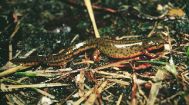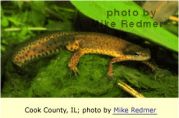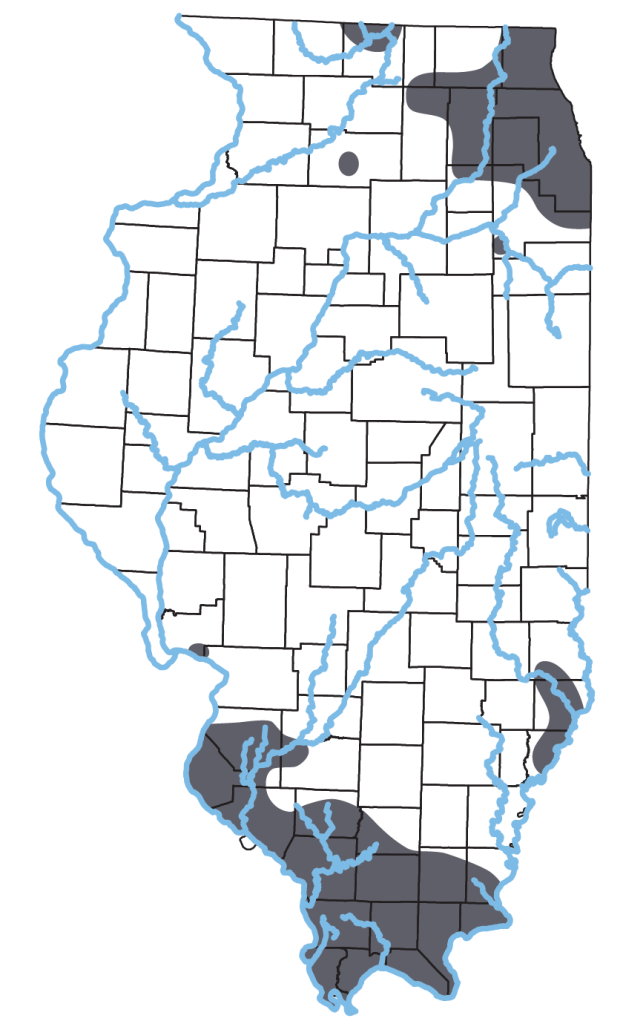Notophthalmus viridescens (Rafinesque, 1820)

Key Characters: No costal grooves or distinct gular fold; raised crests between eyes.
Similar Species: Recently transformed mole salamanders (genus Ambystoma) may be confused with the Eastern Newt, but the latter does not have costal grooves. See Key to Adult and Larval Salamanders of Illinois for help with identification.
Subspecies: Four subspecies are currently recognized; Broken-striped Newt, N. v. dorsalis (Harlan, 1828) ; Central Newt, N. v. louisianensis (Wolterstorff, 1914); Peninsula Newt, N. v. piaropicola (Schwartz and Duellman, 1952); and Red-spotted Newt, N. v. viridescens (Rafinesque, 1820). Only the Central Newt occurs in Illinois.

Description: Small (up to 11 cm TL), olive green to yellowish brown (reddish brown in efts) salamander, with small scattered black dots. Black-dotted yellow belly contrasts sharply with sides. Aquatic adult has tail fin. Breeding male has large hind legs with black ridges on thighs, black toe tips, and conspicuous pits behind eyes. Eft lacks tail fin, has more warty skin, and yellowish or reddish belly.
Habitat: Permanent and semi-permanent ponds and sloughs in or near forests.
Natural History: This salamander has an unusual three-part life history. Adults and larvae are aquatic, but there is an intermediate terrestrial stage called the eft. During spring, adult females attach tiny, pale eggs individually to underwater plants. Best breeding ponds are fish-free, but extensively vegetated borders of stocked lakes are satisfactory. Aquatic larvae transform mid- to late summer into efts, which, after living on land for 1-3 years around bark, logs, rocks, and damp leaves, mature and return to breeding pond. Efts often walk about during the day after rain. In some permanent fish-free ponds, larvae develop into gilled, otherwise-transformed adults. Outside the breeding season, adults may remain in pond or wander on land nearby.
Distribution Notes: Smith (1961) believed that the species “once occurred throughout the state except in the extreme western part”. This was based on his acceptance of three records from central Illinois, all collected by H. Garman. Only the record for McLean County is documented by a specimen; MCZ 2055 and it has not been examined. The remaining two (Peoria Co. & Tazewell Co.) are listed in Garman’s (1892. A synopsis of the reptiles and amphibians of Illinois. Illinois Laboratory of Natural History Bulletin 3(13):215-388). Given Garman’s other questionable records for Illinois, I reject these records and the notion that the Eastern Newt was once found in the Grand Prairie region of Illinois. Rather, it is more likely that the species’ range was bisected by the Prairie Peninsula similar to the range of the Spotted Salamander.
Status: Common in some southern counties where swamps and breeding ponds persist and wooded habitat for efts remains. Reduced in northern Illinois by deforestation and drainage of ponds and marshes.
Etymology: Notophthalmus – nota (Latin) mark; ophthalmos (Greek) for eye; viridescens – viridis (Latin) for green; louisianiensis – (Latin) of Louisiana.
Original Description: Rafinesque, C.S. 1820. Annals of nature or annual synopsis of new genera and species of plants, animals, etc., discovered in North America. Thomas Smith, Lexington. 1:5.
Type Specimen: Not designated.
Type Locality: “in Lake George, Lake Champlain, the springs and brooks of the neighborhood”
Original Name: Triturus viridescens. For the subspecies louisianensis: Diemyctylus viridescens louisianensis Wolterstorff, W. 1914. Über Diemyctylus viridscens Raf., subsp. louisianensis n. subsp. Abhandlungen und Berichte aus dem Museum für Natur- und Heimatkunde zu Magdeburg 2: 383–392). Syntypes: None designated. Type locality: “New Orleans, Louisiana, N. Amerika”.


